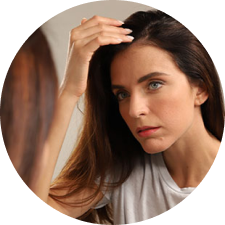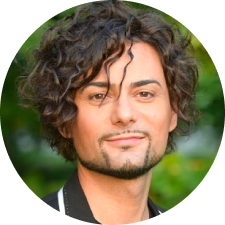- Home
- Dry hair
hair-problems
Dry hair
Scientific collaboration between Professor Marco Toscani and Dr. Pasquale Fino, Chair of Plastic, Reconstructive and Aesthetic Surgery, Umberto I Health Center – “Sapienza” University of Rome.

Often, the presence of dry hair is accompanied by various symptoms such as: dry and brittle hair with split ends, very thin and dry hair that breaks easily, greasy skin and dry hair, dry skin and dry hair, and dry and thin hair that tends to fall out.
The causes that lead to dry hair vary and are difficult to counteract. When the causes cannot be eliminated, treatments focus on the symptoms. This allows for mitigation of the problem and to make it manageable. Among the endogenous causes, we can list hormonal causes, given that hormones influence the formation of hair and hair follicle activity by inhibiting the production of sebum. Another cause can be identified in dietary deficiencies or in a diet lacking in protein, vitamins or minerals. These nutrient deficiencies modify the keratinization process of the hair, thus causing the hair to weaken and become thin.
Genetic causes must also be mentioned: dry hair is hereditary.
An important cause of dry hair is reduced sebum production.
Among the exogenous causes we can list cosmetic hair treatments such as perms, hair dyes, highlighting and frequent use of a hair straightener. Hair straighteners may break hair just like hair dyes and strong ammonium-based and hydrogen peroxide-based hair decolorations. Moreover, in older age hair tends to become increasingly drier due to the progressive atrophy of adnexa and sebaceous glands.
Washing hair too often and the frequent use of aggressive shampoos may cause dryness both of the hair and of the skin. The use of hair dryers at high temperatures or too close to the scalp is another exogenous cause of dry hair.
Among environmental factors, excessive exposure to sunrays, excessively cold temperatures, salt water, pool chlorine and atmospheric pollution damages hair and makes it dry and brittle.
There are many cases of individuals with oily skin and hair that is dry at the ends. This occurs when an excessive quantity of greasy sebum is produced. Greasy sebum, different than oily sebum, adheres to the scalp and does not lubricate hair. In these cases it is important to wash and cleanse the greasy scalp, nourishing and lubricating dry ends. In a nutshell, this re-establishes the acidic-hydrolipidic balance of the skin in order to make hair healthier and shinier. Dryness of the skin and hair may be caused by two factors. The first depends on a defect in sebum secretion which leads to the quantity of lipids expelled onto the scalp being so low that it is unable to lubricate the skin and hair. The second instead derives from reduced sweating, resulting in the sweat glands not functioning as they should and therefore the scalp does not receive thecorrect amount of water, which has the task of evenly spreading sebum throughout the hair.
Dry skin and hair may, moreover, originate from the combination of the two aforementioned causes.
Dry and brittle hair is often the result of a deficiency concerning the lipids and liquids which normally help to untangle hair. When dry hair is associated with dry skin, a greater supply of lipids, water and nutrients is needed so as to stimulate both sebaceous gland and sweat gland function. Laser therapy vascularizes skin, while a daily scalp massage facilitates the secretion of skin.
When the problem of dry hair is not serious it is possible to opt for natural remedies that strengthen the hair via the use of vegetable oil masks, restructuring masks, nourishing shampoos or specific treatments for different types of hair.
Seriously dry, brittle hair that is susceptible to thinning tends to fall out, so it is best to consult a specialist for the correct therapy before it is too late.
Hair and Scalp
READ ALL ARTICLESHair Loss
READ ALL ARTICLESHair Problems
READ ALL ARTICLESScalp Problems
READ ALL ARTICLESAlopecia
READ ALL ARTICLESPreventions and Solutions
READ ALL ARTICLESHair loss solutions for you. CRLAB, specialists in the well-being of your hair and scalp.
FIND YOUR NEAREST CENTER
Let our experts find the best solution for you.
FIND YOUR NEAREST CRLAB CENTERBOOK A CONSULTATION
Book a consultation with our experts. Find out more about CRLAB solutions.
MAKE AN APPOINTMENTTrichology scalp and hair care
To put the health back into your hair, you first need to nourish your scalp. Our trichology treatments care for your scalp and hair, using cutting-edge technologies with a full range of laboratory-tested products. All made with high quality raw materials.
Find out moreHair prosthetic system
The ultimate answer to your hair loss. Rediscover yourself, with naturally thick hair. A patented solution that integrates real hair into areas where you’re experiencing thinning or hair loss. A fully customized hair enhancement that will look totally natural on you. Plus, it’s so functional, it gives you the freedom to live your life the way you want to.
Find out moreHair transplant surgery
Hair transplantation is recommended for those who wish to improve hair density and coverage. The degree of thinning may vary and must be assessed in relation to the donor area.
Find out more
 Italiano
Italiano  Português
Português  Français
Français  Español
Español 




